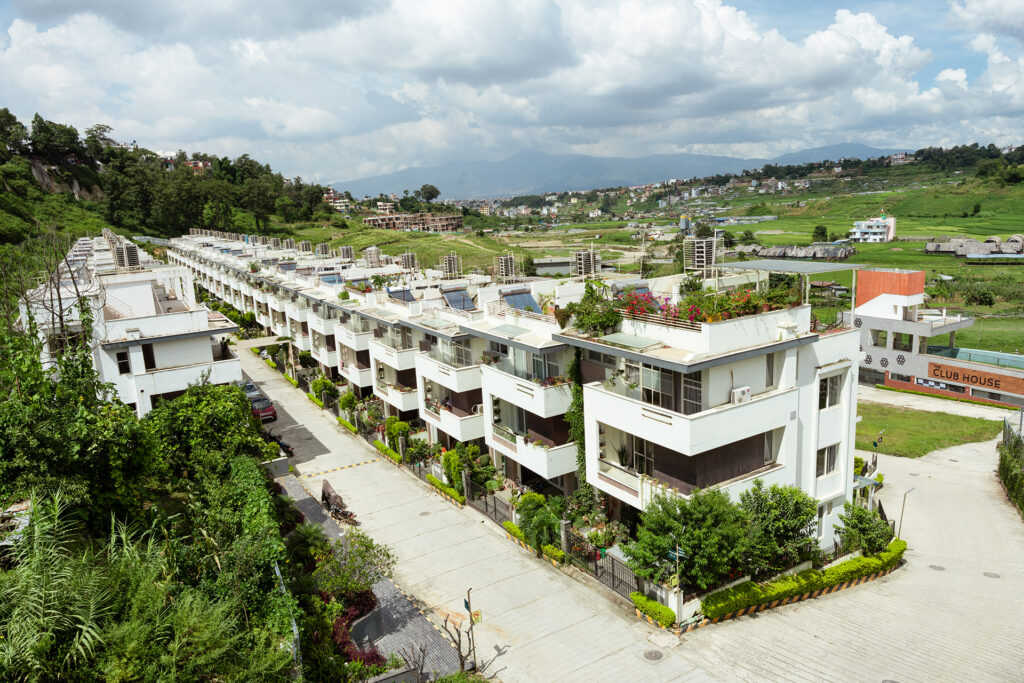In recent years, colonies planned housing communities or “home colonies” have become a major focus in Nepal’s real estate sector. With rapid urbanization, rising incomes, and changing lifestyle preferences, many buyers are turning away from standalone houses towards gated colonies offering amenities, security, and community living.
Among these, Karyabinayak Homes in Lalitpur has emerged as a prominent player, representing many of the trends and opportunities characterizing the colony-market in 2025.
Thus, this article explores the colony market trends in Nepal for 2025, including current demand, price dynamics, growth drivers, challenges, and where Karyabinayak Homes fits into the picture.
Overview of Nepal’s Real Estate & Colony Market Trends in 2025
First, some macro context.
- According to a recent report by Statista, Nepal’s residential real estate market is projected to be worth about US$390.33 billion in 2025, growing annually by approx. 3.12–3.20% (CAGR 2025-2029).
- In fiscal year 2081/82 (mid-2024 to mid-2025), Nepal registered 538,128 property transactions, a modest increase (~0.15%) over the prior year, signaling renewed confidence among buyers and developers.
- The residential segment is the dominant share of real estate value in Nepal, as rising urban migration, remittances, and income growth fuel demand.
Specifically, colony developments (i.e. planned housing estates / gated communities / villa-colonies) are rising in visibility and demand, especially in and around Lalitpur (Bhaisepati, Karyabinayak area), Kathmandu Valley suburbs, and other peri-urban zones.
Key Drivers Behind Colony Market Growth
The steady rise of Nepal’s colony housing sector is not accidental, it’s the result of multiple social, economic, and infrastructural factors working together. Below are the key growth drivers shaping the colony market in 2025, especially in high-demand areas like Bhaisepati and Karyabinayak.
1. Rapid Urbanization and Population Growth
Nepal’s urban population is growing faster than ever, with Kathmandu Valley being the epicenter of residential migration. Young professionals and families from across the country are moving to the capital in search of jobs, education, and better services. As a result, housing demand in organized colonies where people can enjoy both accessibility and a peaceful living environment is soaring.
According to Construction Nepal (2025), over 60% of urban housing demand in the Kathmandu Valley now comes from buyers seeking planned communities or gated colonies, indicating a long-term shift in preference.
2. Affordability and Value for Money
Land prices in central Kathmandu areas like Baneshwor, Maharajgunj, and Lazimpat have skyrocketed, crossing NPR 1.5 crore per aana in some zones. This has pushed many buyers to the outskirts particularly Lalitpur (Bhaisepati, Karyabinayak, Godawari) where colony homes offer larger spaces, better amenities, and more competitive prices.

A villa in Bhaisepati’s Karyabinayak Homes Phase 2, for example, starts at NPR 3.69 crore, while a comparable standalone home inside the Ring Road can exceed NPR 5 crore for smaller land parcels. This affordability advantage continues to draw both residential and investment buyers.
3. Growing Preference for Community and Lifestyle
Today’s homebuyers are not just purchasing walls and roofs they’re buying into a community experience. Modern colonies provide features such as internal roads, 24-hour security, green spaces, and shared amenities like playgrounds and parking areas.
This shift toward community-based living aligns with lifestyle upgrades and safety expectations, especially among young families and NRNs (Non-Resident Nepalis). Projects like Karyabinayak Homes are leading this movement, redefining what luxury and comfort mean in Lalitpur’s housing scene.
4. Infrastructure Expansion and Connectivity
Infrastructure improvements across the valley are accelerating colony development. The Ring Road expansion, Godawari Highway, and newly improved roads in Bhaisepati and Tikathali have made previously “far” areas now highly accessible.
Better water supply, electricity reliability, and waste management systems are also enabling developers to create self-sufficient residential colonies — reducing dependence on congested city cores. As connectivity improves, colony properties near these routes are expected to appreciate by 8–12% annually through 2029.
5. Rising Income Levels and Remittance Inflows
Another crucial driver is Nepal’s steady remittance inflow, which crossed USD 12 billion in FY 2024/25 (Nepal Rastra Bank). A significant portion of this income is channeled into real estate investments.
Many NRNs prefer colonies for their modern design, managed facilities, and long-term appreciation potential. As a result, projects like Karyabinayak Homes are increasingly marketed to NRNs and returning professionals seeking secure and stylish homes in Nepal.
6. Supportive Policy and Housing Finance Access
Recent improvements in housing loans and mortgage systems are also fueling the colony market. Local banks and finance companies have introduced flexible payment options, including pre-handover financing and 70% bank coverage plans, making colony ownership more attainable.
At the same time, government initiatives to digitize land records and streamline approval processes have reduced uncertainty for developers — giving projects like Karyabinayak Homes smoother operational flow.
7. Investment Demand and Rental Yield Potential
Colony properties have emerged as strong investment assets in Nepal’s urban real estate portfolio. While apartment yields average around 3–4%, well-located colony villas can generate 5–7% annual rental returns especially in premium areas with access to schools and hospitals.
Furthermore, capital appreciation has outpaced inflation, making colony homes a safe hedge for investors seeking long-term stability amid volatile financial markets.
Because of the above, colony markets are seeing stronger demand across different buyer segments: young families, NRNs (Non-Resident Nepalis), retirees, and investors seeking rental income.
Price & Transaction Trends in Colonies
To understand the colony market, price trends and transaction data are key. The following tables and statistics illustrate what’s happening, particularly in areas like Bhaisepati, Lalitpur, and similar zones.
Table: Recent Price Trends in Bhaisepati / Lalitpur Colony Sector (2025)
| Property Type | Land/Plot Size | Price Range (per aana / villa) | Key Features |
|---|---|---|---|
| Residential land (colony plots) | 1 aana ~ 35 sq. m | NPR 40-90 lakh per aana | Roads, utilities, near Ring Road; Bhaisepati area. |
| Villas in colonies (Phase II, Bhaisepati) | ~3.5 aana plots | NPR 3.69 crore onwards | Modern villas, earthquake resistant structure, amenity rich. |
| 2.5-3.5 storey colony houses | larger plots | NPR 3.7-6.4 crore | Houses with modern interiors, good road access, desirable neighborhoods. |
Table: Real Estate Transaction & Revenue Trends (Nepal 2024-25)
| Fiscal Period | Number of Property Deeds / Transactions | Revenue Collected (Real Estate Sector) | Key Notes |
|---|---|---|---|
| FY 2081/82 | ~538,128 deeds | ~ NPR 49.04 billion from real estate registration, taxes etc. | Moderate annual increase, marked recovery. |
| Month “Falgun” 2081/82 | — | NPR 4.12 billion | Revenue growth from registration, service taxes, capital gains. |
Buyer Preferences & Colony Type Segmentation
Colonies differ in size, amenities, and price. The market segments roughly as follows:
- Luxury Colonies / Villas: High plot size (3-4 aana+), premium villas, top amenities, locations like Bhaisepati, Karyabinayak. Demand driven by affluent buyers, NRNs.
- Mid-Income Colonies: Smaller plots (1-2.5 aana), more affordable houses or semi-villa units. Strong demand among local professionals, families.
- Affordable Colony Plots / Houses: Even smaller houses or plots in peripheral zones, minimal amenities, targeting first-time buyers or investors.
Karyabinayak Homes’ Phase 1 was villas (~3.5 aana, 4 bedrooms) priced at starting approx NPR 3.31 crore, and Phase 2 continues with similar villa offerings plus better designs and road-connectivity.
Why Karyabinayak Homes Stands Out in 2025
Karyabinayak Homes has become a benchmark for planned residential colonies in Nepal. Located in the rapidly developing Bhaisepati–Karyabinayak corridor of Lalitpur, it seamlessly combines luxury, convenience, and sustainability three pillars driving Nepal’s modern housing revolution.
The project offers independent luxury villas within a gated community, giving homeowners privacy while still enjoying shared amenities, green spaces, and a well-managed residential environment.
With Phase 1 successfully sold out and Phase 2 currently open for booking, Karyabinayak Homes has solidified its position as one of Nepal’s most trusted and in-demand housing projects in 2025.
Here’s why it continues to be a preferred choice for buyers and investors:
a. Prime Location Advantage
Situated just a few minutes from Satdobato and the Ring Road, the colony offers quick access to key landmarks:
- 10 minutes to Jawalakhel
- 15 minutes to Patan Hospital
- 20 minutes to Kalimati or Gwarko
- Nearby schools like Premier International and GEMS
- Shopping and healthcare within 5–10 minutes’ reach
This central yet peaceful location strikes the perfect balance between urban access and suburban tranquility a rare combination in Kathmandu Valley today.
b. Smart Urban Planning
Unlike scattered standalone houses, Karyabinayak Homes follows a systematic urban planning approach with organized roads, underground utilities, and community management. Every unit has uniform elevation aesthetics while still maintaining individuality. The layout ensures proper light, ventilation, and earthquake-resistant safety in every home.
c. Sustainable and Future-Ready Infrastructure
Karyabinayak Homes integrates green construction practices including water drainage planning, open spaces, and energy-efficient systems — meeting the growing demand for sustainable housing.
In 2025, where buyers are increasingly conscious about eco-living, this focus on environmental harmony has become a key differentiator for the brand.
3. Amenities that Define Premium Living
Karyabinayak Homes stands apart through a thoughtfully designed amenities ecosystem, ensuring long-term comfort, convenience, and security for residents.
| Category | Key Amenities |
|---|---|
| Security & Management | 24/7 Security Guards, CCTV Surveillance, Controlled Entry Gates |
| Infrastructure | Wide Blacktopped Roads, Drainage System, Underground Cabling |
| Leisure & Lifestyle | Children’s Play Area, Community Park, Jogging Track |
| Utilities | Regular Water Supply, Underground Waste Management |
| Parking | Private Garage and Visitor Parking Zones |
| Environment | Landscaped Green Zones, Open Terraces, and Airy Courtyards |
In the 2025 market, Nepali homebuyers are no longer only price-sensitive they’re lifestyle-sensitive. The inclusion of green spaces and modern facilities makes Karyabinayak Homes comparable to international housing standards, appealing equally to local professionals and NRN buyers.
Karyabinayak Homes Phase 1
- Type: Villas (2.5 – 3 storey) on ~3.5 aana plots
- Location: Bhaisepati, Lalitpur
- Price: Starting ~ NPR 3.31 Crore
- Amenities: Quality interiors, proximity to schools, hospitals; good road connectivity.
- Performance: Strong demand in Phase 1; units filled faster indicating high trust and desirability.
Karyabinayak Homes Phase 2
- New villas with upgraded features, better layouts, seismic resistance.
- Price has moved to ~ NPR 3.69 Crore for newer villas.
- Internal roads, landscaped public spaces, security.
- Provides exemplar of luxury colony living in peri-urban Kathmandu.
- Its pricing indicates what luxury buyers are willing to pay in 2025 in areas just outside core city zones.
- Sets benchmark for plot sizes, amenities, and pricing for other colony developments.
Challenges & Risks for the Colony market
While the colony market is promising, there are headwinds and risks:
- Affordability crisis: For many middle-income households, even plots in colony projects are becoming expensive. The average worker would need years of savings to buy.
- Regulatory and approval delays: Obtaining permits, Lalpurja, strict zoning norms add cost and time.
- Construction cost inflation: Material price rises (steel, cement) and exchange rate fluctuations add to developer cost, often passed onto buyers.
- Infrastructure shortages: In some colonies, utilities, sewage, road width, water supply lag. The cost of “developing” these in colony areas can reduce net margin.
- Speculative risk: Lots of buyers buy plots long-term with speculation; when market cools, liquidity and resale may suffer. Shrawan 2025 saw cooling in volumes.
Price vs Demand: Data-Backed Insights
Here are empirical observations and data comparisons to show how price and demand are relating:
- The revenue from property registration in months with high activity (e.g. Falgun, Poush) suggests that buyers are willing to transact even at high property taxes and fees.
- Colony villas priced above NPR 3.5 crore still find buyers quickly in areas with good road linkages and serviced utilities. This is seen in Karyabinayak Homes Phase II.
- Demand skew: middle to upper-middle income buyers; many are NRNs or locals returning from abroad looking for quality, secure homes. (Observed in several colony projects)
Opportunities for Buyers & Investors
For those looking to invest in colony housing, or buy to live in colonies, 2025 presents several opportunities:
- Buying early in colony phases tends to give better capital appreciation, as seen in Karyabinayak Phase 1 → Phase 2 price jumps.
- Properties in colonies with strong amenities (road, views, community spaces, security) tend to retain value better and have better resale demand.
- NRN investment: Villas in colonies like Karyabinayak attract NRNs interested in returning homes or second homes.
- Long-term rental potentials: Colonies are more appealing to families needing consistent housing, less transient than apartments.
What to Watch for: Buyer Checklist in Colony Market
To benefit and mitigate risk, buyers should check:
- Ownership & Title: Lalpurja transfer, building permits, correct registration.
- Developer reputation & delivery track record: Projects like Karyabinayak Homes with proven phases indicate reliability.
- Amenities & infrastructure: Road width, water supply, electricity, drainage, internal roads.
- Security & community planning: Gated entries, neighborhood coexistence.
- Seismic/resilience standards: Especially in Lalitpur/Kathmandu valleys, compliance with building code matters.
- Payment plans & hidden costs: Land rights, service fees, maintenance, taxes.
- Market timing & demand: Avoid buying in oversupplied or speculative plots far from amenities.
Price Forecast & Projections (2025-2029)
Based on current trends and data, here are projections for colony market in Nepal:
| Metric | Estimated Annual Growth Rate | Expected Price Increase (2025-2029) | Commentary |
|---|---|---|---|
| Colony land plots in high demand zones (Bhaisepati, Teku fringe, Ekantakuna) | 8-12% | Prices may double over ~5 years in best locations | Driven by scarcity and infrastructure improvements |
| Villas in colonies (luxury segment) | 6-10% | High margin appreciation for stage-1 projects | Premium features and services matter |
| Mid-income colonies | 5-8% | Moderate growth; dependent on connectivity and infrastructure | Closer to ring roads and main roads perform better |
| Rural / peripheral colonies (further suburbs) | 3-5% | Slower growth; more risk of slow demand | Utilities, roads, commuting distance are key inhibitor. |
Challenges to Monitor Going Forward
Finally, any investor or buyer should not overlook:
- Rising interest rates & loan policies: If mortgage rates or down-payment rules tighten (or if LTV falls), buyer affordability could strain.
- Land record & legal issues: Even in Lalitpur, discrepancies in registration, hidden encumbrances, or delays can occur.
- Cost of construction materials: Imported materials, transportation costs, labor shortages may push up costs.
Conclusion
The colony market in Nepal in 2025 is clearly in a growth phase. For many homebuyers, colonies represent a balance of affordability, amenities, and lifestyle that standalone homes in core zones increasingly fail to offer.
Karyabinayak Homes stands out as a benchmark for what luxury colony housing can look like: strong location (Bhaisepati, Lalitpur), thoughtfully designed villas, solid developer reputation, and growing demand.
If you’re considering entering the colony market either for residential use or investment areas like Bhaisepati represent strong opportunities. Especially with projects that are well-planned, offer good construction quality, amenities, and proper legal documentation.
Read More: Karyabinayak Homes Phase 2: Redefining Luxury Living in Lalitpur, Nepal






